The terms additives, boosters, and supplements describe the hormones, bacteria, fungi, sugars, vitamins, nutrients, and other substances medical cannabis gardeners use to improve plant growth. Until recently, most additives were a product of the greenhouse industry or developed by organic gardeners.* Today many additives are being developed and popularized by medical cannabis gardeners and hydroponics manufacturers.
*See “Organic Soil” in chapter 18, Soil, for more information on the contents of organic supplements or additives.
Many of these substances are effective and true to their claims. Some work quickly, while others require a week or longer to affect growth when applied properly. Application and timing are often very important. Be wary of scientifically undocumented claims about products that promise unrealistic results. Manufacturers of such products are more concerned with taking your money than telling the truth. Read advertising carefully and with a critical eye. Go to medical cannabis forums to see how other gardeners fared with the product. Remember that plant growth regulators cannot correct poor gardening practices. Use additives very carefully or not at all when plants are sick. Also, be wary of different “scientific” websites, and know that most blogs are prowled by charlatans. Beware of shills!
Some additives, such as gibberellic acid, ethylene, and fulvic acid, are available in pure form, but most often they are packaged together with other additives in products to perform specific tasks—to promote rooting, setting more buds, growing bigger flower buds, and increasing overall vigor. Again, read labels; be sure you know what all the ingredients are before giving any additives to plants.
Study instructions for additives and carefully determine the correct dosage and application timetable. Additives may be available as liquids, powders, crystals, granules, and more. They are also available in various concentrations. Check with manufacturers and retailers. Most additive manufacturers have a website that provides additional information on their products. As with any additive, make sure the effects of one do not counter the effects of another.
Caution! Additives, especially those containing hormonal products, can be and often are dangerous for the end user. Plant growth regulators (PGRs) are regulated by most governments for a reason— some are proven carcinogens, even at very low rates. Residuals from growth regulators also tend to remain in the plant and in the harvested parts, and are thus passed on to the consumer. The intent of medicinal growing is the same as the intent of a medical doctor—to do no harm. Use of PGR products outside of their specific safety registration is not wise and should be confined entirely to the person or persons that decide to use them, and not passed along to unsuspecting patients or other consumers.
This chapter will give you an overview of additives and how they complement medical cannabis growth.
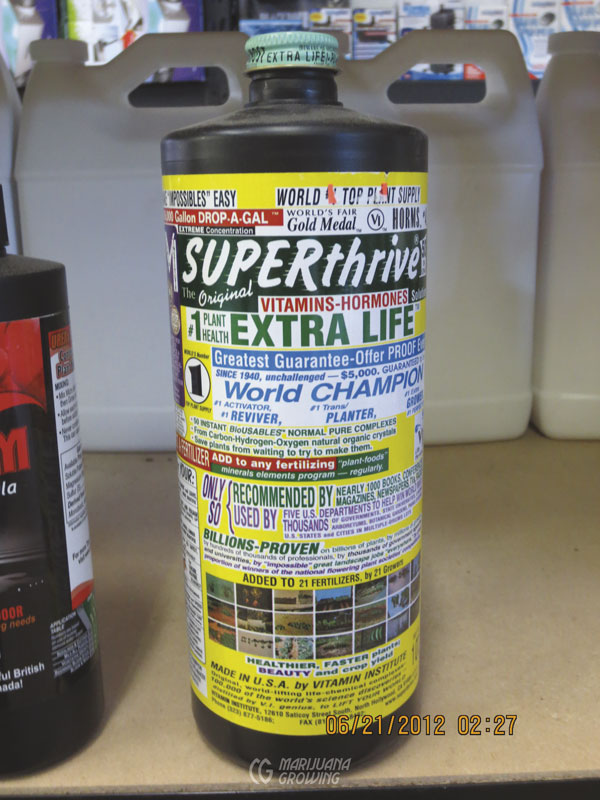
Superthrive was one of the first additives available at garden centers.
Hormones
Plant hormones are chemical messengers that control or regulate germination, growth, metabolism, or other physiological activities such as root growth and flowering. Environmental conditions cause plants to release appropriate hormones that will elicit changes in growth.
These organic compounds are generally effective even at very low concentrations. They interact with target tissues to guide cell growth and development. Each response is often the result of 2 or more hormones acting together. Plant hormones can be naturally occurring within plants, and many can be synthesized in the laboratory, increasing the quantity of hormones available for commercial applications.
Hormones are also called plant growth regulators. The successful use of PGRs is often by trial and error, not an exact science. Understanding cannabis growth and development will diminish the learning curve. Hormones are most effective when applied at specific times, in the proper conditions and dosage, and when integrated into regular growth schedules.
To achieve desired results when experimenting with hormones, pay very close attention to dosage concentration and application time, taking into consideration the time of day and the growth phase of plants. Often, plants being treated with hormones must be isolated. For example, a dilute concentration of auxins encourages cuttings to grow roots. But when overdone, the same hormone (auxin) spurs more of another hormone (ethylene) to be produced. Ethylene, the “death hormone,” causes plants to grow smaller and have thicker stems and smaller flower buds that ripen earlier.
Two valuable hormone classes, cytokinins and gibberellins, can be used to change plant sex, which is very handy when making plant crosses with a single male or female plant. Cytokinins cause female flowers to form on male plants, and gibberellins cause male flowers to grow on female plants. Colloidal silver, which is not a hormone, also makes male flowers grow on female plants.
Abscisin (Abscisic Acid [ABA])
Abscisin maintains dormancy in seeds and can cause dormancy in developed plants. Its primary effect is to inhibit cell growth. Water stress caused by high temperature, low humidity, or a high EC in the growing medium triggers increases in abscisin synthesis, causing stomata to close. It inhibits shoot growth and may stimulate root growth. It may also help defend from pathogens. During winter, abscisin accumulates to slow or stop cell division to protect plants from cold damage or dehydration. In case of an early spring, abscisin will also prolong dormancy, preventing premature sprouts that could be damaged by frost. Abscisin is a gibberellin inhibitor.
Abscisin II is extracted from cotton as the abscission-inducing chemical. Dormin was extracted from sycamore leaves for the same purpose. ABA does induce dormancy in a few species of plants. Mainly it seems to inhibit the gibberellic acid enzyme production pathways.
Applied in the garden, ABA may help plants resist drought and unseasonable conditions, as well as improve plants’ productivity, strength, and performance.
ProTone SL is an example of a product that contains abscisin.
Brassinolide (BR)
Brassinolide is one of the hormones from the brassinosteroid class (plant steroids) that regulate plant development and growth. It promotes stem elongation, root mass, and cell division. It is also involved in other plant processes including drought resistance, stress response, cold resistance, pollen growth, and aging. A deficiency causes stunted growth and infertility. It is a naturally occurring plant hormone that was the first brassinosteroid to be isolated, in 1979. Since then more than 70 BRs have been isolated from plants. Little is known about how BRs relate to cannabinoids. Brassinolide also appears to work with all other hormones to heighten effects or as integral parts of the pathways. They also mimic human steroids and can be anabolic.
MaximaGro is an example of a product that contains brassinolide.
Auxins
Auxins represent a group of plant hormones that regulate growth and phototropism. Auxins affect many processes, including water assimilation, cell division, and cell stretching—often softening cell walls. Top branches grow vertically taller where auxins are concentrated and inhibit lateral buds in the phenomena known as “apical dominance.” “Pinching off” branch tips or pruning branches will reduce the auxin level and encourage bushy, lateral growth as well as inducing new root formation.
Auxins are ingredients in many rooting products because they encourage roots to form on stems. Medical cannabis gardeners use various auxins to encourage root growth. Synthetic auxins are more stable and last longer than natural solutions. In high concentrations, auxins are sometimes used as potent herbicides.
One of the many examples of auxin hormonal action is seen in phototropism, the movement of plants in response to a light source. Light causes auxins to be transported to the shaded side of the shoot. Auxins cause the cells on the shaded side to elongate more than the cells on the lit side. The shoot or leaf bends toward the light and hopefully improves its exposure.
Experiments by Canna proved that weak concentrations of auxins slightly stimulated flower formation but flowers took longer to ripen. High concentrations inhibited growth and caused deformities and tumor-like symptoms.
Indole-3-acetic acid (IAA) is the most potent naturally occurring plant auxin. It is manufactured primarily in young leaf shoot tips, in embryos, and in developing flowers. It suppresses leaf drop and flowering in cannabis. However, IAA is unstable and therefore not used as a commercial plant growth regulator.
1-naphthaleneacetic acid (NAA) is a synthetic organic compound similar to IAA but with a longer shelf life. This man-made plant hormone is included in many commercial rooting products.
This PGR improves cell division and expansion. As a rooting agent, NAA is used for vegetative propagation of cannabis stem cuttings (clones). NAA tends to be counterproductive to seedling root development,as it inhibits taproot growth and enhances horizontal root growth. NAA also suppresses growth tip development, which redirects growing energy to the roots.
4-chloroindole-3-acetic acid (4-Cl-IAA) is a chlorinated derivative of the IAA auxin. Commonly found in legume seeds and believed to be a “death hormone,” maturing seeds use 4-Cl-IAA to induce death of the parent plant and activate nutrients to be stored in the seed.
Indole-3-butyric acid (IBA) is the main rooting plant hormone in many commercial products. It is naturally occurring in small amounts, but most sources are synthetic. Applications of IBA help generate roots, build larger root masses, and improve plant growth and yield.
Many commercial formulas are available in the form of water-soluble salts. Cuttings can be dipped or immersed in IBA before planting, and roots can be dipped, sprayed, or drenched during transplanting. Once established, plants should be treated at 3- to 5-week intervals during the growing season.
There is very little written to support the theory that IBA can be used to encourage regeneration of flowers. However, auxins’ effects are many and wide, including floral production, delaying dormancy, and synergistic effects with many other hormones, especially cytokinins and ABA. We do know that it is a required hormone for proper floral development and that it might be the key in producing another batch of flowers, but regeneration of the plant and plant flowers is doubtful. Commercial auxins such as IBA have many other effects that might be categorized as causing a breaking (growth) of any dormant lateral vegetative buds. This may be more of a cytokinin response as it allows previously differentiated cells to begin division again. IBA’s possible role in the regeneration of flowers remains in controversial, and nothing definitive can be stated at this time.
2-Phenylacetic acid (PAA) is primarily found in fruits. Its effects are much weaker than the effect of the IBA. It is also an ingredient in methamphetamines and is a controlled substance in most countries.
The auxin family also contains man-made synthesized herbicides. The infamous Monsanto-Dow product “Agent Orange” included a 1:1 ratio of the synthetic auxins dichlorophenoxyacetic acid (2,4-D) and 2,4,5-trichlorophenoxyacetic acid (2,4,5-T ). The illnesses caused by Agent Orange are thought to be a result of contaminated 2,3,7,8- tetrachlorodibenzo-p-dioxin (TCDD) as a result of the manufacturing process, and not a result of the auxins.
Products that contain root-inducing hormones are available in liquid, powder, and gel forms. Examples of such products are Rootone (NAA), Hormex (IBA), Clonex (IBA), Schultz TakeRoot (IBA). Many of these products are available in a generic form that costs much less than the name brand.
Caution! IBA and other hormones are hazardous to humans and animals. Some can cause moderate eye injury and are harmful if inhaled or absorbed through the skin. Read the entire label and follow directions!
Cytokinins (CK)
Cytokinins (aka cell division hormones) are plant hormones that promote cell division in root tips and growing shoots. Cytokinins also affects leaf senescence (aging). Naturally found in coconut milk, cytokinins encourage metabolism by stimulating the transport of sugars and bud development on side shoots. Concentrations are highest in young leaves, root tips, and seeds. Cytokinins also stimulate female flowers to form on male plants.
Added to the soil or sprayed on plants, cytokinins help plants make efficient use of existing nutrients and water in drought conditions. Leaf surfaces are larger and flower formation is faster in cytokinin-treated plants, but harvest time is the same as if cannabis plants were untreated.
Take extra care when using or experimenting with cytokinins mixed with other plant hormones. Many commercial formulas contain hormone cocktails that may include both auxins and cytokinins, which can work in opposition to each another. A high ratio of auxins to cytokinins stimulates root formation. A low ratio promotes shoot formation.
Derivatives of the adenine-type include 6-benzylaminopurine, kinetin, and zeatin. The most active and common is zeatin, isolated from corn (Zea mays). Cytokinins are synthesized in the roots, promoting cell division, chloroplast development, and leaf development, and delaying leaf aging. As an additive, cytokinins are most often derived from the kelp Ascophyllum nodosum. Look for seaweed products that contain this seaweed. Kelp meal is also added to many organic fertilizers.
6-benzylaminopurine (BAP) is a synthetic cytokinin used to encourage growth, flower setting, and cell division. Pure BAP does not dissolve directly into water; it is first combined with alcohol or another solvent and then diluted with water. BAP is commercially available as the product Configure.
According to some gardeners, a concentration spray of 6-Benzylaminopurine at 300 ppm halfway through flowering will increase flower bud growth and weight.
Kinetin is a cytokinin often used in plant-tissue culture combined with an auxin to induce callus formation. Cytokinin derivatives have been synthesized and many are as effective as kinetin. Different cytokinin:auxin ratios affect growth rate of plants. For example, if kinetin is high and auxin is low, shoots are formed; if kinetin is low and auxin high, roots are formed. Kinetin suppresses ethylene production. Many antiaging skincare cosmetics use kinetin.
Zeatin is a cytokinin growth hormone used to encourage lateral plant growth. Upon germination, zeatin moves from the endosperm to the root tip where it stimulates mitosis. It encourages auxiliary stem growth that sets more buds. Coconut milk is a naturally occurring source of zeatin. Zeatin is also commonly used in skincare products. It is available as a white crystal powder and in an aqueous solution.
Products that contain cytokinins include Maxicrop, Dr. Earth Kelp Meal, Neptune’s Seaweed, Alg-A-Mic, and Bushmaster.
Ethylene (Ethene)
Ethylene is a naturally occurring hormone that activates the aging and ripening of flowers and fruit, prevents the development of flower buds, and retards plant growth. Roots, senescing flowers, and green growth tips contain the largest amounts of ethylene. It is the primary hormone responsible for chlorophyll destruction, leaf detachment, flower senescence, and fruit ripening. This growth regulator is called the “ripening,” “post-harvest,” or “death” hormone.
Ethylene concentrates in plant tissues when plants suffer stress. Production will increase in roots when necessary to add girth so they can penetrate hard, impairing surfaces. In windy areas outdoors or indoors where a fan is blowing too much air, plants produce more ethylene to increase stem diameter and counteract effects from the wind. The result is thicker stems on smaller plants with small buds that ripen prematurely.
Soggy, waterlogged growing mediums cause ethylene to accumulate in the root zone and migrate up the stem as severity increases. Symptoms include leaf yellowing (chlorosis), thickening of stems, leaf margins curving downward, and greater vulnerability to diseases and pests.
Avoid infusing ethylene where young plants are present, or you will risk dwarfed growth, premature flowering, and small flower buds. Stressed and flowering plants release ethylene that must be vented and removed daily when they are around young plants, to prevent the risk of premature ripening.
Ethylene is also a by-product of fossil fuel combustion in CO2 generators. High concentrations will cause leaves to yellow very quickly. Adequate ventilation will evacuate “toxic” levels of ethylene. Minute concentrations as low as 10 parts per billion (ppb) in the air can cause abnormal growth and susceptibility to diseases and pests. Excess ethylene can also be a major issue with improperly vented or unvented gas heaters as well as leaking heat exhaust systems, and is normally seen in colder months when plants are grown indoors.
In a sealed environment, natural ethylene production levels increase over time. A closed refrigerator allows ethylene to build up. Any closed environment— a paper bag, room, or jar—will have a similar effect. Placing fruit, tomatoes, or avocados in a sealed paper bag will speed ripening. Ripe fruit will emit ethylene and impact harvested cannabis flower buds in the vicinity. Storage areas should have adequate ventilation to evacuate built-up ethylene.
Sealing dry cannabis in a vacuum will decrease ethylene production by lowering temperature and available oxygen. Ventilation will carry away ethylene and reduce levels to tolerable concentrations.
Seed treatment with carbon dioxide or ethylene before sowing has a positive influence on growth, budding, flowering, and ripening of hemp. Root development, seed production, and total yields also are increased by treatment.
Products that contain ethylene include Ethephon, Etacelasil, Glyoxime, and Sensa-Spray, and are most often available in a liquid (foliar spray). Be careful using Ethephon and Etacelasil or any other systemic plant regulator. Once sprayed with a PGR, plants should not be consumed.
Caution! Ethylene can be phytotoxic if applied during hot weather or when improperly diluted. Isolate plants so that nontarget plants are not affected.
Gibberellins
Gibberellins are natural plant growth hormones that act with auxins to break dormancy and increase seed germination, stem diameter, fiber content, and vertical growth. Found naturally in seeds and young shoots, they stimulate cell division and elongation. At least 75 plant-based gibberellins have been isolated. They are referred to as GA1, GA2, GA3, and so on. Gibberellic acid (GA3) is the most common.
Gibberellic acid is an ingredient in commercial products and is used to extend the garden season and force larger blooms in some agricultural crops. It is widely used in the grape-growing industry to increase production of larger fruit bundles and bigger grapes, and to produce grapes on seedless varieties. GA3’s primary use in cannabis gardens is to increase plant height and encourage male flower development on female plants. Be very cautious with application rates; plant stems can grow, stretching up to 4 inches (10 cm) a day! Application during vegetative growth delays flowering.
Pollen from male flowers that were induced with GA3 on female plants is used to pollinate female flowers. Resulting seeds from this union always produce female (feminized) plants. Low doses (25–100 ppm) of GA3 sprayed on female plants for 7 to 10 days immediately before flowering will cause up to 80 percent of treated plants to grow male flowers. Use this pollen to pollinate “feminized” seeds. For more information, see chapter 25, Breeding.
Environmental factors also cause extra gibberellin production. Low light levels cause gibberellin production that results in lanky growth. Too much light causes buds to shoot up, creating tall, narrow flower tops. A rule of thumb is to keep a 600-watt lamp a minimum of 20 inches (50 cm) above the plant canopy.
When seeds absorb water, gibberellins develop in the embryo and activate plant metabolism to initiate sprouting. GA3 helps difficult-to-germinate seeds sprout. However, I advise to use scarification (see chapter 5, Seeds & Seedlings) rather than GA3.
GibGro is an example of a product that contains gibberellic acid. It is available in 5 percent, 10 percent, and 20 percent wettable powder packages, as well as the 4 percent liquid solution.
Caution! If misapplied, gibberellic acid can cause very tall, lanky cannabis plants.
Jasmonate (JA)
Jasmonate is, by definition, a hormone, although it arises from linolenic acid as either jasmonic acid, a response to insect attack primarily involved in gene activation and expression, and jasmonate, which activates resistance, as well as pollen and anther development.
Salicylates (Aspirin) [ASA]
Aspirin, or salicylic acid, is effective in preventing pathogens (bacteria, fungi, and viruses) by speeding up the natural “systemic acquired resistance (SAR)” and thereby reducing the need for pesticides. It is a naturally occurring plant hormone associated with willow tree bark. Often, plants do not produce enough on their own to be effective. Salicylic acid (SA) will block abscisic acid (ABA), allowing the plant to return to normal after a period of stress—something to consider if ABA is being used to strengthen plants. It is added to a vase of water to prolong the life of cut flowers.
Aspirin can be ground up and diluted in water to be used as a spray or soak, or it can be added to compost and rooting compounds. A 1:10,000 solution used as a spray will stimulate the SAR response, and the effects will last weeks to months. “Willow water” also makes a popular rooting bath. See “Willow Water” in chapter 7, Clones & Cloning.
Many forms of salicylic acid are available in the form of aspirin.
Caution! Some people have an allergic reaction to salicylic acid, which is responsible for numerous deaths in the world every year.
Enzymes
Enzymes are biological protein catalysts that accelerate rates of reaction but do not change themselves as a result of this action. They are added to fertilizers and growth additives to accelerate biological activity and speed nutrient uptake by roots. For example, the enzyme nitrate reductase reduces nitrates and steals electrons for energy, breaking them down into the nitrite form. This is the first step in assimilating N into organic compounds. Nitrite reductase assimilates nitrite into the ammonium ion.
Ammonium is then transferred to the vacuole if high levels are present of 2 other enzymes: glutamine synthetase, which reduces ammonium to glutamine, or glutamate synthase on its way to being converted into amino acids.
More than 1,500 different enzymes have been identified. Enzymes are grouped into 6 main classes: oxidoreductases, transferases, hydrolases, lyases, isomerases, and ligases.
Enzymes are a naturally occurring by-product of composting. Many seaweed extracts are brimming with enzymes (along with many trace elements, hormones, etc.). However, as their function tends to be isolated to cellular function outside of soil or medium function, I am unaware of any beneficial use in applying enzymes.
Most enzymatic reactions occur within a temperature range of 85°F to 105°F (29.4°C–40.6°C), and each enzyme has an optimal pH range for activity. Most enzymes react with only a small group of closely related chemical compounds. Enzymes are highly specific and only function on their matching substrate. For instance, cellulose only breaks the bonds of cellulose, pectinase only breaks down pectin, and individual molecules are usually used over and over until they lose their form, or denature. Also, soil enzymes work at standard soil temperatures of 70ºF to 80ºF (21ºC–26ºC]) even though they can speed up, with elevated chemical reactions coming at higher temperatures.
Cellulase is a group of enzymes that act in the root zone to break down organic material that may rot and cause disease. Dead materials are converted into glucose and returned to the substrate to be absorbed by the plant. Cellulase breaks down cellulose fiber. For example, the enzyme contained in the product Cannazym breaks down dead root cellulose and hemicelluloses into simple sugar compounds. Cellulase is used throughout production as roots are constantly shed. It also functions against the cell wall that contains cellulase of several classes of fungi including the water molds (Pythium, Phytophthora) and Rhizoctonia (decreases the availability of its parent material before its populations get to plant-affecting levels), providing some protection from these pathogens.
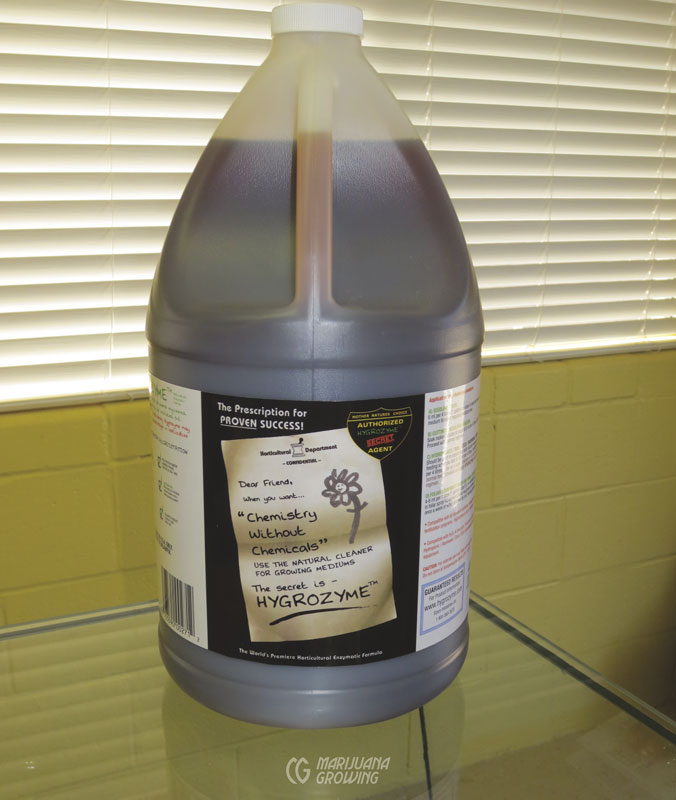
Some products that include enzymes are Sensizym, Hygrozyme, Power Zyme, and Cannazym. Many organic compost products contain beneficial enzymes.
Amino Acids
Plants produce biosynthesize amino acids naturally. Applying specific supplemental amino acids as a foliar spray or soil drench can increase crop yield and quality. Amino acids can directly or indirectly contribute to a plant’s physiological activities. Apply specific amino acids as a soil drench or foliar spray to help improve soil life, which in turn facilitates nutrient uptake.
Note: A complete discussion of the many, many amino acids is beyond the scope of this book. This is an isomer form known as an optical isomer that occurs in two states, the L and D forms effectively doubling. Also, plants’ amino acid uptake is species dependent, and ectomycorrhizal roots expand this. For instance, the Scot’s pine is known to take up 13 types of amino acids, all L isomer and all basically containing 15 nitrogen and 13 carbon atoms. However their function seems to be relatively the same in that they are used for the ammonium ions and the carbon they contain…the only direct uptake and utilization of carbon.
Plants absorb amino acids best through foliar spraying. There is a soil life benefit from exposure, and at least partial soil application is recommended.
Colchicine
Colchicine, an alkaloid, is prepared from the dried corms and seeds of the autumn crocus (Colchicum autumnale) that produces saffron; it is available in the form of a pale-yellow, water-soluble powder.
Caution! Colchicine is a very dangerous, poisonous compound. Colchicine poisoning is similar to arsenic poisoning. Cannabis breeders have used it to induce polyploid mutations, and more than 30 years ago started producing polyploid varieties with colchicines. None of the varieties showed outstanding characteristics, and their cannabinoid levels were unaffected.
Colchicine can also be used to induce female chromosomes in female plants that produce seeds. However, many of the resulting seeds may not sprout, and a large percentage of them could have intersex (hermaphrodite) tendencies.
Rather than explain how to use colchicine, I will advise not to use it. It is very toxic and produces no change in potency. I do not know any seed breeders that use it today. If you are not convinced, search the Internet for “colchicine poisoning.” For more information, see Marijuana Botany by Robert Connell Clarke.
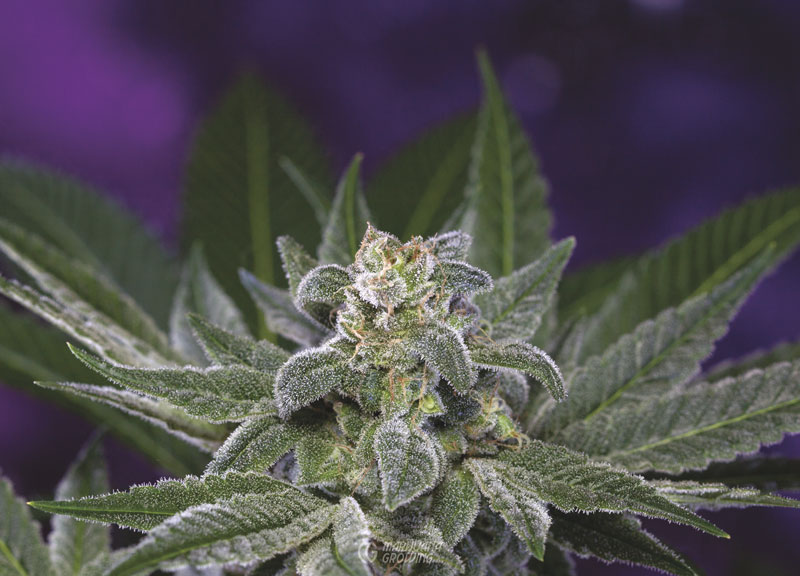
Beautiful ‘Mom Booey’ × ‘Kona Sunset’ bud!
Humic Acids
Humic acids are carbons formed by the decomposition of organic matter, primarily vegetation. It is not a single acid; rather, it is a complex mixture of many different acids. Often humic acids are “talked up” by vendors making outrageous claims. Scientific research proves that humic acids do 4 basic things: (1) act as a colloid in providing structure in the soil, (2) act as chelating agents to facilitate nutrient availability to the plant, (3) act like a docking station by attaching to a single cation-exchange site and providing space for many elements to bind, and (4) increase cell permeability, which would also allow for better nutrient uptake. Cannabis roots and plant tissue do not take in humates. Humates act in the soil and help nutrients become more available. Canada does not allow “humates” on fertilizer labels, and neither does the Association of American Plant Control Officials.
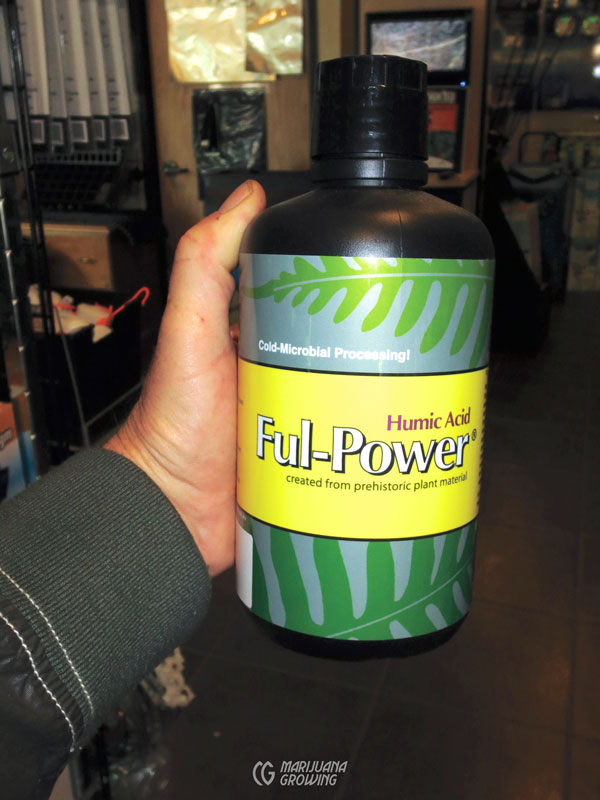
Humic acid is available in liquid form
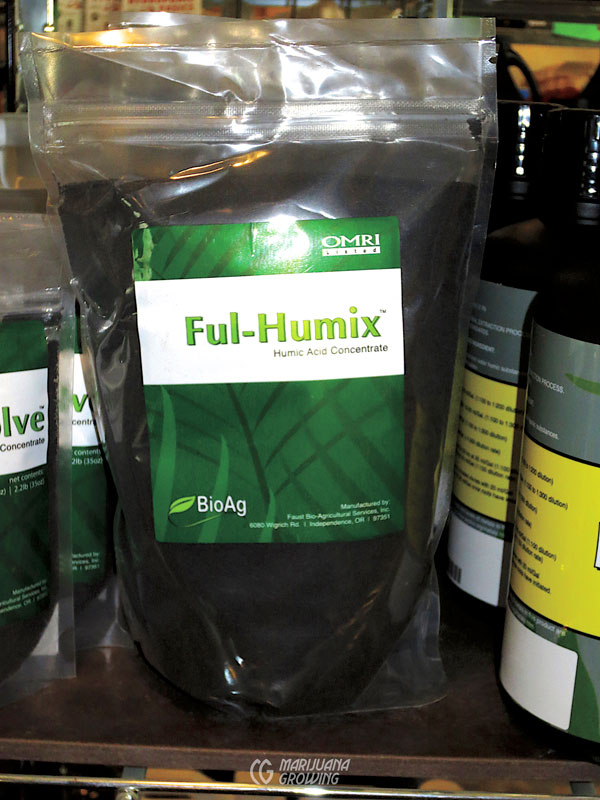
Humic acid is also available in powder form to dilute in water
Humates Chelate
Organic humic and fulvic acids chelate semisoluble metallic ions (nutrients), making them readily transportable by water. This ability is dependent upon the water pH level. Copper, iron, manganese, and zinc are difficult to dissolve. When mixed in a chelated form, they become readily available for absorption.
Humus is formed from compost that has matured to the point of stability. It is so stable and so mature that it can remain unchanged for thousands of years in that state. Humic acid, fulvic acid, and humin are all humus extracts. Humic acid is made from finely grinding humus and then adding a low-pH water solution so humic acid can be separated from the fulvic acid. Humic acid helps free nutrients from the soil so they become available to the plants.
Humin is the fraction of the soil’s organic matter that is not dissolved when the soil is treated with this alkali. Colors range from yellow (fulvic acid) to brown (humic acid) and black (humin).
Fulvic Acid
Fulvic acid is a humic acid that has a lower molecular weight and higher oxygen content than other humic acids. Fulvic acid is commonly used as a soil supplement. Contrary to popular belief, fulvic acid is not able to be absorbed into plant tissue and is not an antioxidant.
Fulvic acid is the fraction of humic substances that is water soluble under all pH conditions. Fulvic acid stays in solution after humic acid dissipates due to acidification. Fulvic acids are polyelectrolytes, unique colloids that easily diffuse through membranes.
Gardeners can create fulvic acid by composting, or it can be purchased from a retailer. It is available in forms that are suitable for hydroponic or soil mediums. See “Organic Soil” in chapter 18, Soil, for more information on fulvic acid.

Distinguish fulvic and humic acids and humin by color.
Fungi
Mycorrhizal Fungi
Mycorrhizal refers to a class of fungi that forms a symbiotic relationship between mycelium of specific fungi and roots of plants. The ectomycorrhizal fungal hyphae (microscopic strands that grow from fungal spores) surround and encapsulate roots and exchange nutrients because they are so close together. Endomycorrhizal fungal hyphae actually enter the cells of roots to exchange nutrients. Mycorrhizal fungi grow around and even penetrate root tissue and grow out into the soil to find more water and nutrients than roots could find on their own. This is essentially a second root system that improves water and nutrient uptake and contributes to the overall health of the plant.
The two fungi species that are known to colonize the roots of cannabis are Glomus intraradices and Glomus mosseae. Make sure these species are included in any mycorrhizal fungi product you purchase. These species have the maximum potential to colonize cannabis roots. However, there are many mycorrhizal fungi that have yet to be discovered and studied.
Mycorrhizal fungi naturally occur in areas where plants are not disturbed by human activity, but these beneficial fungi are often lacking in urban and indoor environments.
Mycorrhizal fungi take time to become established enough to be of assistance to the plant, so they should be introduced early in a plant’s life cycle. Apply spores to seeds or a cutting’s roots when planting. It can take 6 weeks or longer for full mycorrhizae colonization to occur. Plants that grow for 3 months or more receive the most benefit from mycorrhizae colonization.
Apply fungal spores to the seeds or prepared cuttings’ roots when planting or transplanting. For best results, inoculate the root zone with a high spore (propagule) count per gram. Typically, G. intraradices powder-based products have about 3,200 spores per gram, and liquid products have about 2 million spores per gram. G. mosseae is typically available at 200 spores per gram. Most mixes don’t contain both G. intraradices and G. mosseae. You may have to pur- chase them separately in bulk. Here is a good resource for products: www.usemykepro.com.
Encourage mycorrhizae by inoculating soil. Compost tea, fulvic acid, humic acid, and carbohydrates are used to promote healthy mycorrhizae growth. Add as a soil amendment or mix with a nutrient solution and use as a drench. Incorporate mycorrhizal fungi into the top 4 inches of soil, or mix with potting soil when planting.
Here is an example of a mycorrhizal fungi mix that comes from my friend Sannie in the Netherlands.
Analysis:
93 endomycorrhizae spores / gram
Glomus intraradices
Glomus clarum
Entrophospora colombiana
Glomus sp.
Glomus geosporum
Glomus mosseae
Glomus etunicatum
Rhizobacteria:
Bacillus subtillus
Paenibacillus azotofi xans
Bacillus pumilus
Bacillus polymixa
Bacillus megaterium
Bacillus licheniformis
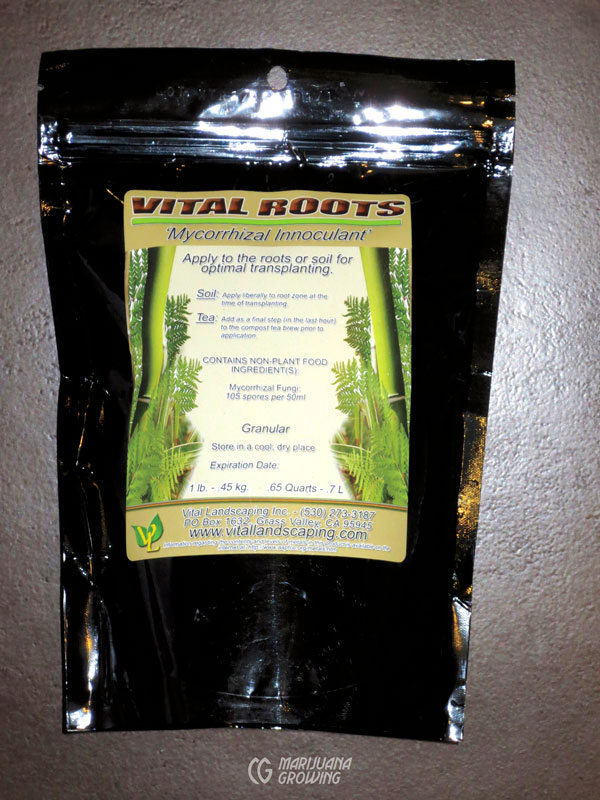
Mycorrhizal fungi, available in powder form
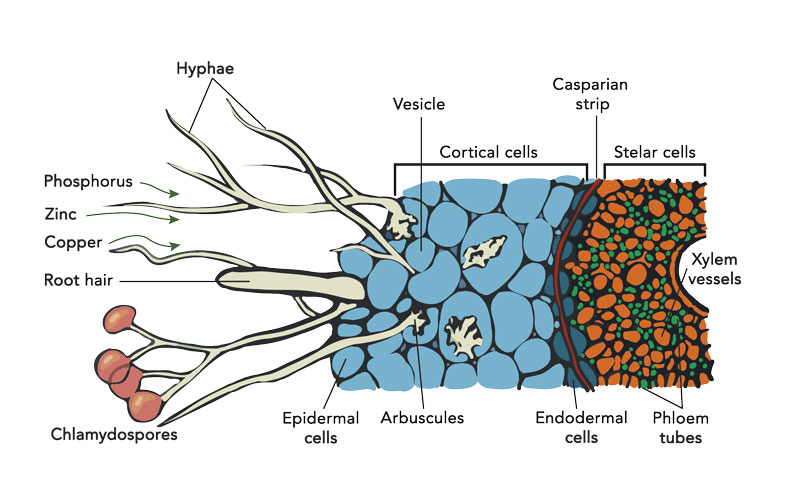
Mycorrhizal fungi help make nutrients in the soil more readily available for uptake. Most organic molecules, especially long-chain types derived from humates breaking down to form humic and fulvic acids, are not taken up by the roots or through the leaves, and the same is true for the fungi.
Trichoderma
Trichoderma are fungi that colonize in the root zone, crowding out negative fungi and microorganisms while stimulating root development and resistance to environmental stress. The result is a stronger, more vibrant plant. Trichoderma are naturally present in coconut fiber and growing medium. Note that sterilizing coco growing medium with steam or other means kills Trichoderma.
There are 89 species in the Trichoderma genus. Several varieties of Trichoderma have been developed as biocontrol agents against fungal diseases of plants. The various mechanisms include antibiosis, parasitism, inducing host-plant resistance, and competition. Most biocontrol agents are from the species Trichoderma harzianum, T. viride, and T. hamatum. The biocontrol agent generally grows in its natural habitat in the rhizosphere on the root surface, and affects root disease in particular but can also be effective against foliar diseases. Trichoderma is also effective in suppressing pathogenic fungi that cause damping-off—rot in the seeds, roots, and stems. Some strains of T. harzianum have an antagonistic effect on Botrytis cinerea development in some crops.
Canna was the first company to popularize a commercial product as a growth promoter that contains Trichoderma fungi. Now there are many similar products available. Trichoderma products can be applied to seeds, used during transplanting, mixed with liquid fertilizer or via drip irrigation, and/or watered in. Quality Trichoderma products contain living organisms that will reproduce after application, so a small amount will do a lot. Most all are nontoxic and environmentally safe. There is one documented case of a human Trichoderma-related death in South America; the species invaded the digestive system and blocked it.
Products that include Trichoderma species include Promot Plus and Canna Trichoderma Powder. Trichoderma are naturally present in coconut fiber, compost, and compost tea.
Bacteria
Bacteria, considered the earliest form of life, are found in virtually every environment on earth. For at least 3 million years they have managed to adapt to most environments and avoid extinction. Single-celled bacteria are so small that 250,000 to 500,000 of the little single-celled organism could fit on the period to a sentence. More than a billion bacteria, constituting hundreds of species, are found in a single gram of soil. Overall, microscopic bacteria are beneficial to plant growth.
Bacteria are one of the main decomposers of fresh green organic garden matter. Different bacteria eat diverse organic matter. Beneficial bacteria travel short distances and promote good health in medical cannabis. Once food and nutrients are inside bacteria, they are “locked up” until the bacteria are consumed. There are 2 groups of bacteria: aerobic and anaerobic.
Anaerobic bacteria do not need oxygen to survive. In fact, O2 is poisonous to them. In general, anaerobic bacteria are to be avoided and not promoted. By-products of some anaerobic organic decomposition include hydrogen sulfide and butyric acid, both of which smell like vomit, and ammonia, which smells like vinegar. If you know these odors, you know the smell of anaerobic decomposition. Conditions that promote anaerobic bacteria include standing water or compacted soil with little pore space.
A few species of anaerobic bacteria attack plants. They launch their assault on sick plants with few defenses, or ones that are suffering from diseases or pest wounds. Bacteria colonize, entering through weak tissue and wounds. However, healthy plants are very resistant to bacteria attacks.
Aerobic bacteria need oxygen to live and, overall, are the ones we want in the garden. For the most part, aerobic bacteria are beneficial, but parasitic varieties do exist. Aerobic, organic decomposition does not cause unpleasant odors; instead, it has a sweet, earthy fragrance.
Bacteria recycle 3 basic elements: carbon, nitrogen, and sulfur. Sulfur-oxidizing bacteria make water-soluble sulfates available to plants. Bacteria convert inert atmospheric nitrogen into “fixed” nitrogen—ammonium, nitrate, or nitrite ions. Bacterial slime (biofilm—DNA, proteins and sugars) also buffers the rhizosphere so the pH remains reasonably constant. Bacteria attach to particles of soil and lock up nutrients. The nutrients stay in the same place in the soil and are not leached out. When other organisms eat the bacteria, nitrogen is released in their poop—right next to the rhizosphere where it is readily available to roots. Bacteria act as living containers of organic fertilizer and also serve as food to members of the soil food web.
Beneficial bacteria need decomposing plant material to thrive, and a pH around 7.0. Bacteria are naturally occurring worldwide and will form in the correct environment.
Healthy compost teas are rich in beneficial bacteria.
Rhizobia
Nitrogen in the air becomes “fixed” by rhizobia—bio-fertilizing bacteria. Naturally occurring bacteria such as rhizobia live in the roots of legumes (beans, clover, peas, peanuts, etc.). Once colonized with the bacteria, legumes will create nodules that act in symbiosis with the plant. Because of this symbiotic relationship with nitrogen-fixing bacteria; legumes can be planted as companion plants to cannabis. They are often referred to as “plant growth promoting rhizobacteria” (PGPRs).
Rhizobia are host-specific according to their type and will not work with all crops. With the proper host, however, rhizobia fix atmospheric nitrogen while simultaneously providing an additional source of available nitrogen. Rhizobacteria are added with legume cover crops to improve nitrogen levels in depleted garden soil. The product Azopar contains nitrogen-fixing Azospirillum inoculum for non-leguminous plants.
Miscellaneous Additives
Alginic Acid
Alginic Acid (aka algin or alginate) is an anionic polysaccharide found in cell walls of brown algae. When it binds with water, it forms a viscous gum that holds vast quantities of water. The extracted form soaks up water quickly and can absorb 200 to 300 times its own weight in water. Its color ranges from white to yellowish-brown.
Products that include Alginic acid include: B52, Dr. Earth Kelp Meal, Neptune’s Seaweed, Alg A Mic. Many seaweeds and kelps include alginic acid.
Carbohydrates and Sugars
Carbohydrate is a hydrate of carbon. Carbohydrates provide energy to living cells, such as soil life. They are compounds containing carbon, hydrogen, and oxygen with a ratio of 2 hydrogen atoms for every oxygen atom. Carbohydrates are known as sugars, starches, saccharides, and polysaccharides.
Sugars are carbohydrates that can be used immediately to supply energy to living organisms. Molasses, honey, and other sugars can increase soil microbial life, enhance growth, and make the plant’s use of nitrogen more effective. Molasses is the “secret ingredient” in many organic fertilizers, and the natural sugar best for organic medical cannabis crops. Sucrose (corn) syrup is the most economical way to buy sugar, but it lacks many of molasses’ qualities.
Plants manufacture sugars. Plant roots do not absorb sugars, raw or refined. Bacteria and other soil life consume sugars as food or fuel. Adding organic sugar in the form of molasses to the soil increases soil life and biological processes in and around the root zone. The extra life allows roots to absorb nutrients more quickly and efficiently, which increases plant growth. In fact, flower buds can gain up to 20 percent more weight when a regular regimen of molasses is added to irrigation water.
Buds grow bigger because there was more microbial activity in the soil. Sugars feed the soil life, and more healthy microbial activity makes more nutrients available that are taken in faster. And the soil life releases the carbon as CO2 that moves up through the plant canopy, enhancing CO2 uptake and subsequent carbohydrate production by the plant.
Add sugar (molasses) at the rate of 2 tablespoons per gallon (4 ml/L) to soil, starting during vegetative growth and continuing through flowering. Adding more will not increase plant growth; instead it will imbalance soil life and attract scavengers.
NOTE: Any sweet taste or flavor that vendors attribute to coming from sugars, does not come directly from adding sugars or flavorings to the nutrient solution. If they insist that it does, I would like to see scientific proof. Please have them contact me immediately.
Molasses
Molasses is available in 3 main types: unsulphured, sulphured, and blackstrap. One of the ingredients in some compost and potting soil is molasses waste. Molasses is made from several sources, including corn, sugar beets, and sugar cane.
Unsulphured molasses is top quality and is used in cooking. This grade is made from ripe sugar cane juice that is clarified and concentrated. It can be used in the garden.
Sulphured molasses is made from unripe (green) sugar. Sulfur fumes are applied during sugar extraction. Afterward it is boiled repeatedly. First-boil molasses is of the highest quality because only a small amount of sugar is removed. Second and any subsequent boils turn the molasses dark in color and extract more sugar. It can be used in the garden.
Blackstrap molasses has been boiled three times to extract ever more sugar. Mainly used as cattle feed, it is heavy with iron. It can also be used in the garden.
Overall, the average N-P-K analysis of molasses is 1-0-5, and it contains potash, sulfur, and many trace minerals in a chelated form. It is also packed with carbohydrates and a balance of consumables, which are a quick source of energy and food for microorganisms. Molasses can be purchased at grocery, health food, and livestock feed stores.
Products that contain molasses include Hi-Brix, Bud Candy, FloraNectar, and Sweet. It is also available in bulk form for livestock or human consumption. Most molasses is applied at the rate of 1 to 2 tablespoons per gallon.
Caution! Molasses and products that contain it attract large and small scavengers. I have visited more than one garden where molasses-based products attracted bears.
Colloidal Silver (CS)
Colloidal silver is made of particles of metallic silver suspended in distilled water. It is sprayed on female cannabis plants to encourage male flower development. Seeds from a plant using the pollen from these male flowers will be “feminized.” Silver ions also inhibit the (female) hormone ethylene. Many commercial cannabis seed producers use colloidal silver to create feminized seeds.
A few ounces (ml) of colloidal silver can be purchased online, at many health food stores, and at some drugstores for $30 to $40 USD. It can be made at home by connecting leads to each terminal of a 9-volt battery and a piece of pure silver, which may be hard to find. Each lead (– and +) is connected to a piece of pure (0.999%) silver, usually a coin. The pieces of silver, attached to the battery via clips, are submerged in a small quantity of distilled water and left for several hours. The coins are not allowed to touch one another. The electrical current will deposit minute silver particles into the water, creating colloidal silver. Detailed instructions are available on the Internet.
To apply, mist target branches with a 30 to 40 ppm solution of colloidal silver solution every day, starting a week before flowers emerge. Spray at the same time early in the day, and continue spraying daily until male flowers clearly appear. Pollen from these male flowers is used to fertilize female flowers. The resulting “feminized” seeds will grow female plants.
Caution! Health risks! Do not consume plants that have been treated with colloidal silver. However, it is considered safe to consume cannabis that was grown from seeds that were produced from a mother treated with colloidal silver. Some gardeners spray only one branch with colloidal silver and consume the balance of the plant. They shield the nontarget foliage when spraying. I advise against this practice.
Many products contain emulsified colloidal silver.
Caution! Store colloidal silver in a lightproof container. It kills beneficial bacteria and fungus, so avoid soil contact. It may also be toxic to humans.
Hydrogen Peroxide (H2O2)
Hydrogen peroxide (H2O2) is similar to water but carries an extra, unstable oxygen atom. This extra atom will either attach itself to another oxygen atom or attack an organic molecule. In medical cannabis gardens, hydrogen peroxide can provide a host of benefits by cleansing water of harmful substances such as spores, dead organic material, and disease-causing organisms while preventing new infections from occurring. It also suppresses algae growth. It removes the methane and organic sulfates often found in well water, as well as removing chlorine from city tap water.
Hydrogen peroxide is often mistakenly used in soil and hydroponic gardens to provide oxygen in substrates with poor soil biology, compaction, and overwatering. Purveyors mistakenly believe that it prevents oxygen depletion in the water around the roots. The free radicle O2- will rapidly combine with anything but other oxygen molecules. Oxygen is only useful to any life form in the diatomic format O2. Saturating the medium or water with hydrogen peroxide may clean the water, but it will kill roots as well. There is no oxidative value in this product, and it should be employed only as a last ditch attempt to save a crop from disease issues.
Hydrogen peroxide also kills other soil life and retards root growth. Small root hairs are very delicate and so is much soil life. Adding H2O2 will impair or kill some of the soil life and disrupt soil chemistry. Be extremely careful and sparing when using H2O2. Do not use it as a regular constituent of a nutrient or additive program.
Hydrogen peroxide is dangerous at high concentrations and will damage skin, clothing, and most anything else it contacts. Find low-concentrate H2O2 (3%, 5%, and 8%) at drugstores or supermarkets. “Food grade” hydrogen peroxide (35%) will need to be diluted before use. Higher strength H2O2 formulations are more economical but should be diluted (to 3%) before use.
Wear rubber gloves when using any concentrations above 3%. Hydrogen peroxide concentrations higher than 3% cause bleaching and damage to skin and other surfaces. Clean up splatters and spills to avoid problems. Store hydrogen peroxide in a dark container that holds pressure to preserve potency.
Hydrogen peroxide is best purchased as a generic product in a 3% solution. Stronger 35 percent solutions are available but require more care in handling.
Caution! Use gloves when handling; concentrations above 3 percent can burn skin. Keep away from eyes. Keep out of children’s reach. Avoid spilling; it can bleach and damage fabrics or surfaces.
| APPLICATION GUIDELINES FOR 3 PERCENT H2O2 SOLUTION | ||
| Task | teaspoon/gallon | ml/L |
| irrigation | 1.5–3.8 tsp/gal | 2–5 ml/L |
| seed soak | 7.5–11.5 tsp/gal | 10–15 ml/L |
| antifungal and anti–root rot | 15 tsp/gal | 20 ml/L |
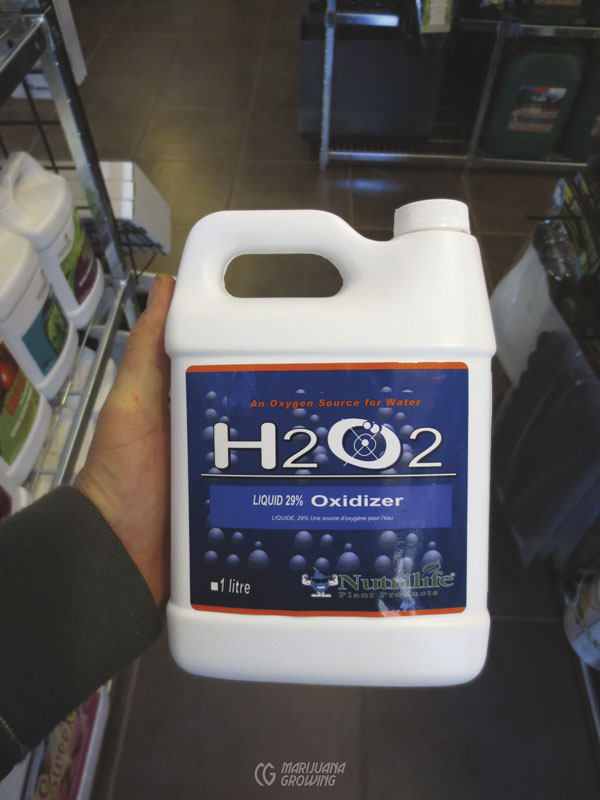
Hydrogen peroxide (H202)
Propolis
Propolis is a resinous mixture that honey bees collect and use as a sealant in hives. It is collected from tree bark and other plant saps. It is sticky above room temperature and hard-to-brittle at lower temperatures. It is used as a local antibiotic and antifungal agent. Propolis is an ingredient in some additives. Propolis can be used as part of a treatment regimen for infected or sick plants.
Propolis may be available from local beekeepers.
Triacontanol
Triacontanol (aka melissyl alcohol or myricyl alcohol) is a naturally occurring fatty acid and growth stimulant. It speeds cell growth and increases cell division, which in turn boosts overall flower yield. Triacontanol is readily available and abundant in alfalfa meal. See “Alfalfa Meal” in chapter 21, Nutrients, for more information.
Some products that include Triacontanol include AlfaGrow, Final, Nirvana, and Bloom. Alternatives include Alfalfa meal and pellets.
Caution! Triacontanol can be toxic. It is a saturated fat, and, in some eyes, a plant growth regulator, although there is still some debate on the issue. Triacontanol is not taken up by the plant.
Vitamins
Vitamins C and B1 as aids may be myths. B9, a growth inhibitor, is the only one I’ve found that appears to actually have any use to medical cannabis gardeners.
Ascorbic Acid (Vitamin C)
Vitamin C is thought to build tighter, heavier buds and act as an antioxidant. It is often combined with fructose, molasses, or sugar, and added to the nutrient solution during the last 2 weeks before harvest. However, some botanists believe that although vitamin C is very important in fighting the free radical by-products of photosynthesis, plants make their own vitamin C and are unlikely to recognize any benefit from its addition to the nutrient mix.
Vitamin C tablets sold at grocery stores and drugstores contain ascorbic acid but may contain other things too. Purchase it in the pure form, L-ascorbic acid or L-ascorbate. Ascorbic acid is a better supplement for gardeners than it is for cannabis!
B Vitamins
B1 , aka Thiamin, thiamine, and aneurine hydrochloride, is the term for a family of molecules sharing a common structural feature responsible for its activity as a vitamin. Applying vitamin B1 to root systems of plants does not stimulate root growth. This common misconception has been repeatedly refuted in scientific trials.
B3 Niacin is used as a root growth factor. There is no concrete evidence proving that it helps plant growth.
B9 (folic acid, folinic acid) appears to serve in energy transfer within the plant and inhibits the enzyme that makes gibberellic acid, resulting in a bushier, dwarf-type plant without pruning. B9 can be applied as a spray or as a soil drench. It effectively suppresses growth when applied frequently at low concentrations. Flowering onset and harvest are progressively delayed with increased applications, but flower buds tend to all ripen simultaneously.
Folic acid is also used to increase vase life in cut flower buds and branches. A few branches of a male plant can be kept “fresh” for several days. Dilute B9 in water and store cut branches of flower-producing male plants to keep them “fresh” for longer periods. B9 is considered to be a safe, short-term growth retardant with few phytotoxicity problems.
Products that include B vitamins include Ortho Vitamin B Blend and B-52.
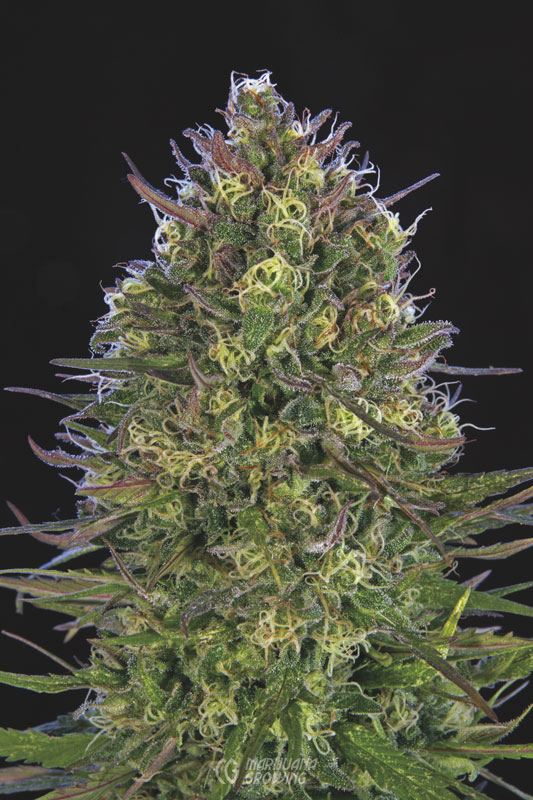
‘Cripple Creek’ bud a week from harvest
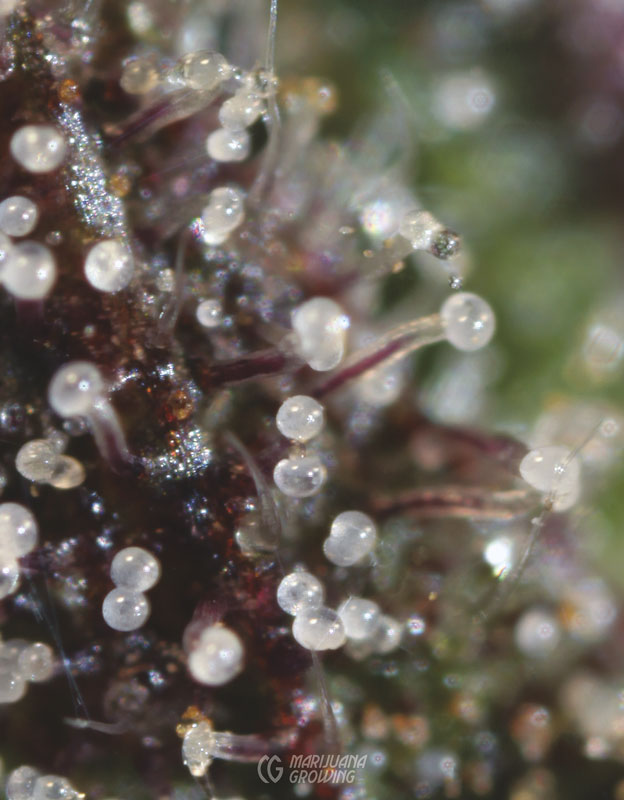
‘Cocoa’ macro close up showing capitate-stalked resin glands
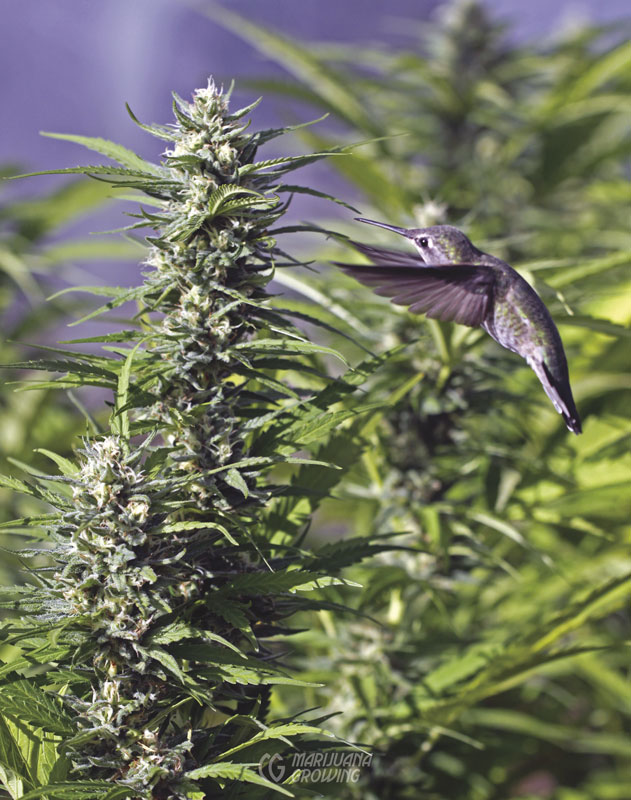
Hummingbird inspecting a ‘Jolly Bud’
Growth Retardants
Caution! Do not use growth regulators on cannabis! NO GROWTH REGULATOR IS LABELED FOR HUMAN CONSUMPTION. All growth retardants leave residues in the plant, and some, like paclobutrazol (aka Bonzi or Bushmaster, among others) remain in the plant for years and will show up in the buds and other foliage. The use of some PGRs will show up in the seeds.
In the USA and Canada, none of these products is allowed on the shelf or for use without a license to sell and apply. One company, Dutch Master, almost went out of business because their formula contained growth regulators. Growth regulators CAUSE CANCER and immune system problems, and have very low mammalian toxicity values and even lower primate values. Ethylene (the gas) and Ethephon (the liquid that converts to ethylene on heating) are about the safest alternatives.
Ill-informed cannabis growers apply growth retardants to inhibit vertical growth and increase internodal branching. Leaves are supposed to remain the same size but internode length is retarded. Deadly toxic growth retardants are often called “chemical pinchers.”
Outside of the use of PGRs for root induction in cuttings, and maybe working with seed production, I would not knowingly consume any plant or plant part that PGRs have been used on. There is a level of risk here that is unacceptable. It makes zero sense to use PGRs in commercial grows and even less in medical gardens.

